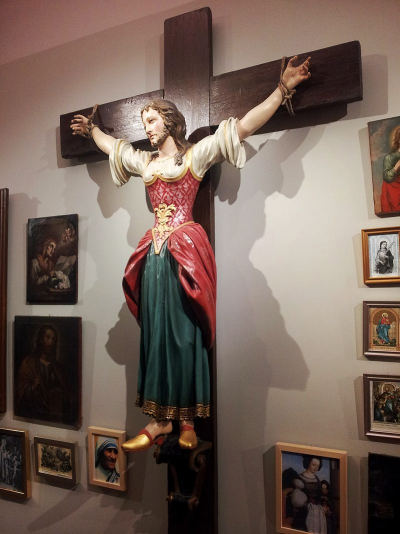Cheers for that
@Swifty - it led me down an internet rabbithole of learning who St. Uncumber (also known as Wilgefortis) actually was. According to Wikipedia (I know, I know) a "fictitious female
folk saint venerated by
Catholics whose legend arose in the 14th century,
[1] and whose distinguishing feature is a large beard".
The Wikipedia entry
here says that she came about because of a tunic wearing, bearded representation of Christ:
"Art historians have argued that the origins of the art can be found with Eastern-style representations of the crucified Christ, and in particular the
Holy Face of Lucca, a large 11th-century carved wooden figure of Christ on the Cross (now replaced by a 13th-century copy), bearded like a man, but dressed in a full-length tunic that might have appeared to be like that of a woman instead of the loin cloth familiar and by the
Late Middle Ages normal in depictions in the West.
https://en.wikipedia.org/wiki/Wilgefortis#cite_note-6
The theory is that when the composition was copied and brought north of the Alps over the next 150 years, in small copies by pilgrims and dealers, this unfamiliar image led Northerners to create a narrative to explain the
androgynous icon.
[6] Some older images of the crucified Christ were repurposed as Wilgefortis, and new images clearly intended to represent the saint created, many with female clothes and breasts."
I still like to learn something new every day!

ETA: [I also learned that 'uncumber' (rather than un
encomber) is actually a word (although archaic)]
ETA2: I can understand the confusion

:
View attachment 51340


 ) ... and not forgetting the woman the church is named after who gave to birth to Jesus a virgin plus the woman who grew a beard over night to repel a pagan man with God's help. That's some pretty miraculous women attached to the history of this church right there. I can't wait to find out who's bodies are in that crypt.
) ... and not forgetting the woman the church is named after who gave to birth to Jesus a virgin plus the woman who grew a beard over night to repel a pagan man with God's help. That's some pretty miraculous women attached to the history of this church right there. I can't wait to find out who's bodies are in that crypt.
